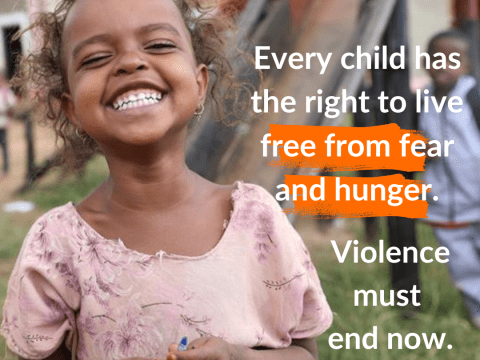Listen to the Future in East Africa

Today, on International Children’s Day 2024, World Vision East Africa reaffirms our commitment and promise to the well-being of the most vulnerable. As this year’s theme aptly urges us to, “Listen to the Future,” we reenergize our ministry to them. How we protect, educate, nurture, and empower them in the present will significantly shape the future they will inherit.
Today, children in East Africa face an array of challenges. Conflict disrupts lives in Sudan, Somalia, South Sudan and Ethiopia, forcing families to flee their homes and depriving children of safety, stability, and access to education. Of particular concern, is the dire food insecurity in the region, occasioned by the polycrisis of conflict, climate change and economic hardship.
Nearly 313 million people in the region are food insecure, with over 3.5 million children under the age of 5 severely affected. This crisis contributes to alarming rates of malnutrition, as 3 in every 10 children under 5 are stunted.[1] This reflects chronic malnutrition. Compounding these issues, over 250 million people in the region live on less than $1.90 per day, limiting access to proper nutrition and essential services such as healthcare, clean water, and quality education[2]. These realities underscore the urgent need for intervention to ensure every child has the opportunity to thrive.
World Vision’s ENOUGH Campaign to end child hunger and malnutrition envisions a world where every child has enough nourishing food and thrives through food security, nutrition, and resilience. By prioritising interventions that directly impact vulnerable children, the campaign ensures that more children benefit from access to the right food, nutritional support, and life-saving interventions. World Vision’s comprehensive approach includes providing enough food for children in emergencies, securing funding to combat child malnutrition, and implementing school meal programs that hold immense potential in transforming lives.
Child protection is a priority. In East Africa, millions of children are exposed to violence, exploitation, and abuse. Sudan hosts about 11 million IDPs with 53% of the IDPs are children under the age of 18 years.[3] Nine-year-Old Najma, a refugee child from Sudan, paints a melancholic picture of the situation, "We have faced significant challenges, including my father's injury, and the loss of our home, village, school and all our properties. Upon arriving in El Abbassiya, we struggled a lot to gain access to food due to insufficient funds and high market prices." World vision’s intervention continues to offer respite to the vulnerable children in the conflict.
We need to be firmer in our resolve and promise to create a safer, healthier and a happier world for these children. All advocates for child wellbeing must unite to create systems that uphold children's rights, promote their well-being, and provide them with the tools they need to thrive.
But as do all these, we need to recognize the power of children’s voices. As we advocate for their rights, let us remember that children are our principal stakeholders and foremost allies in this endeavor. We must prioritize empowering them to express their views and including them in decisions that affect their lives. Both the United Nations Convention on the Rights of the Child (UNCRC) and the African Charter on the Rights and Welfare of the Child emphasize the right of children to participate in decisions affecting them.
World Vision East Africa collaborates with the East Africa Children's Advisory Group, a crucial platform that ensures children's voices are meaningfully integrated into our programme and advocacy. In October we convened for a children’s nutrition dialogue, where children from Ethiopia, Kenya, Tanzania, Somalia and South Sudan shared their perspectives on food security and nutrition such as nutritious school meals, affordable local food and the importance of exercising. Through the Children's Advisory Group, World Vision strengthens its commitment to placing children at the heart of all our work, ensuring their voices are heard and their rights are upheld. As an organization we are accountable to the recommendations made by children during the ENOUGH Campaign launches. During the last nutrition dialogue, children from across East Africa shared their recommendations on improving nutrition in the region. Teddy Nabukenya from Uganda proposed that the government introduce a school feeding program where children could access fresh meals at school. She also suggested that schools engage in farming initiatives, such as establishing school gardens, to promote better nutrition. Mubarak Mohamed from Somalia emphasized the importance of education on irrigation as a critical step toward enhancing food security and improving agricultural practices in the region.
In light of all these highlights and the theme of this year’s World Children’s Day, World Vision East Africa recommends to:
Encourage and support child-led initiatives in raising awareness about nutrition issues, empowering children to be advocates for change in their communities.
Ensure that children’s views on nutrition and food security are included in national policy discussions, so that their needs and solutions are reflected in government plans.
Expand and institutionalize school meal programs across the region to ensure all vulnerable children have access to nutritious food
And while at it, let us also celebrate the resilience of our children in the face of all the adversity. Let us ensure that every child in East Africa and beyond has the opportunity to thrive and succeed.
#All4Children #WorldChildrensDay
[1] United Nations Children’s Fund (UNICEF), World Health Organization (WHO), International Bank for Reconstruction and Development/The World Bank. Levels and trends in child malnutrition. Key findings of the 2023 Edition
[2] FAO, AUC, ECA and WFP. 2023. Africa - Regional Overview of Food Security and Nutrition 2023:Statistics and trends. Accra
[3]International Office of Migration (IOM), 2024, Sudan Mobility Report Overview 3, Bi Monthly Report September – October 2024